Facilitating equitable prevention and management of gout for Māori in Northland, New Zealand, through a collaborative primary care approach
Aniva Lawrence 1 7 , Sharon Scott 1 , Fabio Saparelli 2 , Georgina Greville 3 , Andrew Miller 4 , Andrea Taylor 5 , Peter Gow 61 Manaia Primary Health Organisation and Te Tai Tokerau Primary Health Organisation, PO Box 1878, Whangarei 0140, New Zealand
2 School of Medicine, The University of Auckland, Private Bag 92019, Auckland 1142, New Zealand
3 Department of Rheumatology, Middlemore Hospital, Private Bag 93311, Otahuhu, Auckland 1640, New Zealand
4 Bush Road Medical Centre, PO Box 4320, Kamo, Whangarei 0112, New Zealand
5 Northland District Health Board, Private Bag 9742, Whangarei 0148, New Zealand
6 Rheumatologist, Counties Manukau District Health Board, Private Bag 94052, South Auckland Mail Centre Manukau 2240, New Zealand
7 Corresponding author. Email: AnivaL@manaiapho.co.nz
Journal of Primary Health Care 11(2) 117-127 https://doi.org/10.1071/HC18082
Published: 18 July 2019
Journal Compilation © Royal New Zealand College of General Practitioners 2019.
This is an open access article licensed under a Creative Commons Attribution-NonCommercial-NoDerivatives 4.0 International License.
Abstract
INTRODUCTION: The Gout Stop Programme was developed for primary care in Northland, New Zealand, to address inequitable health outcomes for Māori and Pacific people with gout.
AIM: The aim of the programme was to make it easier for clinicians to prescribe urate-lowering treatment, facilitate patient adherence through education and support, and reduce barriers to gout prevention and long-term management.
METHODS: From 2015 to 2017, patients with acute gout who met inclusion criteria were prescribed treatment according to a ‘Gout Stop Pack’ option, based on renal function and diabetes status. Patients were monitored by community pharmacists. Gout educators and a Gout Kaiāwhina (community support worker) provided education and support to patients and whānau (families). Patient completion of the programme and outcomes, according to target serum urate level, were recorded. Patient experience was documented using a questionnaire and rating scale.
RESULTS: In total, 160 clinicians prescribed therapy at 887 patient presentations; 71% were Māori and Pacific patients. The completion rate was 55% in this group and 84% for the non-Māori and non-Pacific group. In the Māori and Pacific group, 40% reached the target serum urate level (≤0.36 mmol L-1) in 91 days, and 26% required further titration. In the non-Māori/non-Pacific group, these rates were 51% and 19% respectively. Following programme completion, 68% of Māori and Pacific patients and 65% of non-Māori and non-Pacific patients continued to take allopurinol. The 21 patients interviewed rated the programme as excellent or very good.
DISCUSSION: Culturally appropriate education and support for patients and the primary care team was essential. Collaboration between prescribers, community pharmacists and support workers reduced barriers to initiating prevention and long-term urate-lowering treatment and urate testing in this high-needs gout population.
KEYwords: Gout; medications; blood testing; primary health care; Māori health services; Pacific communities
| WHAT GAP THIS FILLS |
| What is already known: Gout prevalence is disproportionally high in Māori and Pacific people and is often undertreated in this group of people compared to non-Māori and non-Pacific people. Urate-lowering treatment is effective, yet patients with gout are often poorly managed with sub-optimal treatment. |
| What this study adds: The Gout Stop Programme highlights the importance of empowering patients to understand the management and prevention of gout, particularly among Māori and Pacific populations. Collaboration between general practitioners, community pharmacists, community support workers and health organisations is important in initiating prevention in high-needs populations who have the greatest gout prevalence, and in establishing patients on long-term allopurinol treatment. |
Introduction
Gout, a common type of inflammatory arthritis, is a chronic disease that occurs with elevation of serum urate, causing the formation and deposition of monosodium urate crystals within joints.1 Although a chronic condition, patients often present with recurrent flares, which are acute and extremely painful events. Metabolic syndrome, renal impairment, hereditary factors and diuretics are key risk factors for gout.2
In 2016, it was estimated that gout affected ~5.2% of New Zealanders.3 In Northland, gout prevalence was 7.7%.3 In Māori and Pacific peoples, the prevalence of gout is higher than for non-Māori/non-Pacific people. Sixty percent of the variation in urate levels between individuals can be attributed to inherited genetic variants.4 Māori and Pacific people’s increased prevalence of gout can be partly explained by reduced renal excretion of uric acid. Key proteins for the renal excretion of uric acid are affected by the genes SLC2A9 and ABCG2, with the SLC2A9 genetic variant more prevalent in Māori and Pacific people.5
Oral urate-lowering therapy is effective in reducing serum urate levels to below the saturation point for monosodium urate crystals, inhibiting formation and inducing dissolution of these crystals. This effectively counteracts the cause of the acute pain symptoms of gout and reduces future joint deformities. Gout can be effectively managed with allopurinol, provided it is started at a low dose and titrated upwards monthly until the target urate level of <0.36 mmol L-1 is achieved. This treatment has been available for years, yet most people do not receive effective treatment and suffer from the painful symptoms of gout.1 Inadequate treatment may be due to beliefs and stigma surrounding gout, to prescriber knowledge, variable approaches to treatment or the target urate level not being achieved or maintained. A short course of prednisone and colchicine can be used to control symptoms of acute gout and flare ups during initiation of urate-lowering therapy.
The Gout Stop programme is based on the publication entitled ‘Treating acute gout and starting prevention in 7 minutes’.6 Goldfien et al.7 in the US and Phone8 in New Zealand have published other pharmacist-led collaborative programmes, but neither included a community support worker role. Northland’s high Māori and Pacific populations,9 the inequity of gout-related health outcomes in Māori and Pacific people3 and the need to individualise treatment to achieve successful gout prevention and management are further driving factors promoting the development of the Gout Stop Programme. The programme aims to discover and reduce barriers to accessible gout treatment, specifically for Māori and Pacific people, and thereby achieve equity of health outcomes.
A common barrier to managing gout effectively is that patients may have a limited understanding of the condition and its treatment.10,11 Building on patient knowledge and providing information for people at risk of, or with, gout is needed to improve health outcomes.10 In addition, raising awareness and understanding of gout in the community is important.
Based on the positive outcomes and lessons from a pilot project involving 20 patients in 2014, the programme was modified to include an option for diabetic patients and inclusion of community support workers, and was rolled out progressively to clinicians across Northland. The treatment protocol was endorsed by rheumatologists and the renal team at Whangarei Hospital. A target of >70% Māori and Pacific patient participation in the programme was set to address the goal of reducing health inequities. The programme has subsequently been adapted for local patient needs and is monitored by an oversight group comprised of a clinical lead, programme coordinator, general practitioner (GP), community pharmacist, specialist rheumatology nurse, Gout Kaiāwhina and the funder.
Methods
This is an open evaluation based on the collection of data from patients enrolled in the programme and prescribed the treatment protocol. Descriptive statistics were used and project approval was granted by the Northern Ethics Committee in 2015 (NDHB Locality Assessment No: 2016–5).
The population included patients from low socioeconomic communities who presented with an acute attack of gout and a history of two or more attacks per annum, according to the inclusion and exclusion criteria shown in Box 1. The treatment options included a combination of medications (prednisone, allopurinol and colchicine) prescribed for 91 days, based on the patient’s renal function (eGFR in mL/min/1.73 m2) and presence of diabetes as a comorbidity. In the diabetes option, naproxen was selected instead of prednisone. The prescription option, known as the ‘Gout Stop Pack’ and specific programme laboratory form were built into Practice Management System (Medtech 32, Medtech Global Limited, Auckland, New Zealand), allowing easy selection by clinicians (Box 2). A ‘GP Flow Chart’ described the process followed during the programme (Box 3).
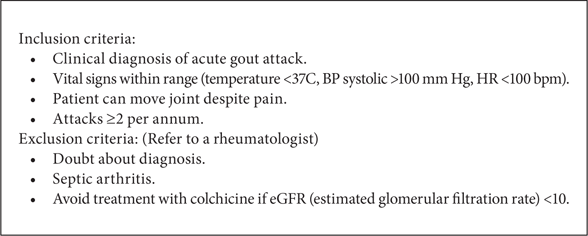
|
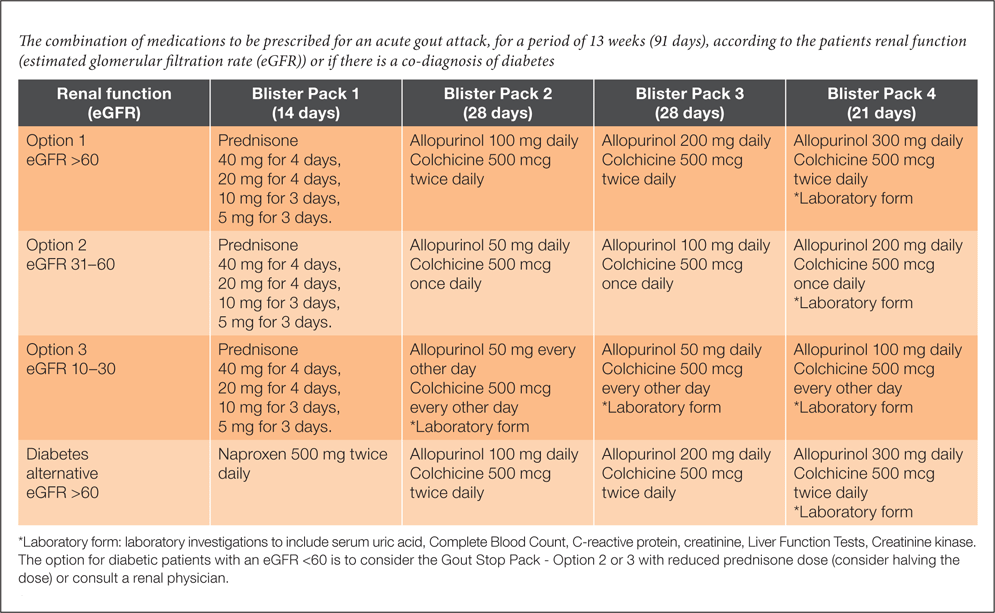
|
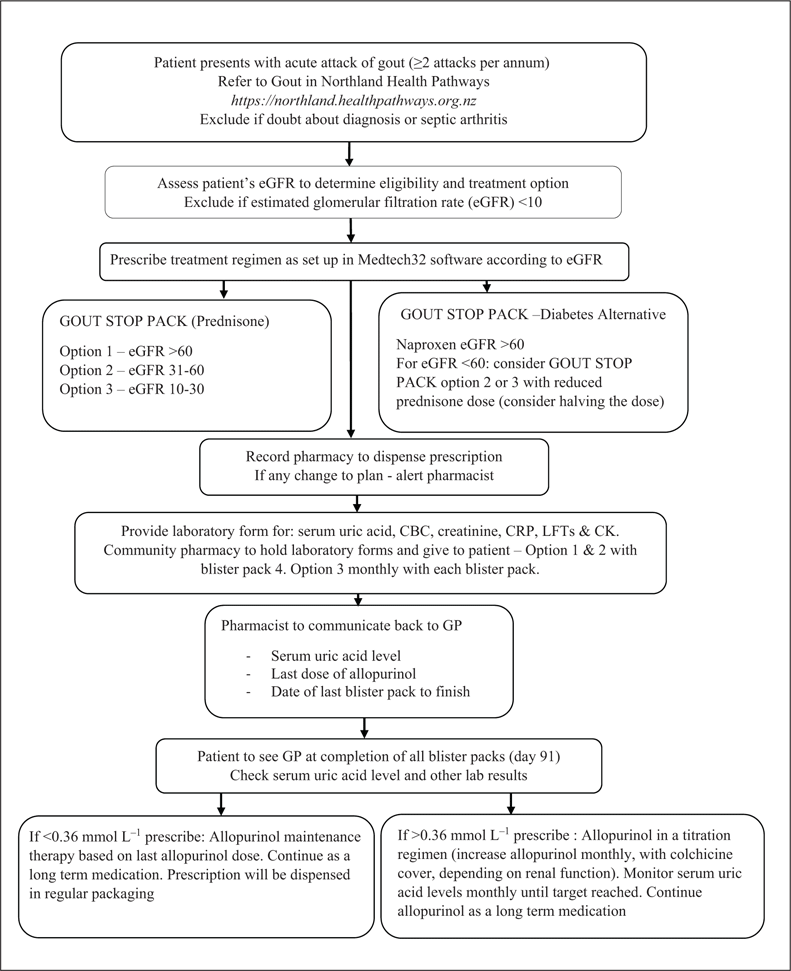
|
Medication was dispensed by a community pharmacist according to the prescription for the ‘Gout Stop Pack’. The medication was provided in free-of-charge blister packaging on four occasions and regular contact was maintained to guide patients through the process. Patients were advised when to have laboratory tests, the serum urate result was checked in the clinical information sharing service, TestSafe, and the level and patient outcome was communicated to the prescriber.
Patients who completed the programme were categorised based on their serum urate levels as follows:
Success: patient completed the programme and reached the target serum urate of ≤0.36 mmol L–1.
Titration: patient completed the programme but had not reached the target serum urate of ≤0.36 mmol L–1.
No level: patient completed the programme but no serum urate level was available.
Patients who did not complete the programme were categorised based on the reason for non-completion as follows:
Disengaged: patient disengaged due to personal or social factors.
Withdrawn: patient was removed by the prescriber or specialist due to comorbidities or side-effects.
Lost to follow up: patient was uncontactable or had moved away.
Community pharmacists were contacted either by telephone or email between April and December 2017 to determine whether two cohorts of patients had allopurinol prescribed following completion of the programme. Pharmacists used the booklet ‘To Stop Gout’12 as an education tool to give to patients. An informative video about the programme and its benefits was created; this includes narratives from both the health-care team and patients who participated in the programme.13
In consultation with Emergency Department clinicians, patients presenting to Emergency Department with acute gout were prescribed 2 weeks of prednisone and given a voucher for a free-of-charge GP visit in order to be enrolled in the programme. Patients were followed up and outcomes recorded.
Arthritis New Zealand Gout Educators provided support to patients who consented until September 2017. A Gout Kaiāwhina role was then created to support patients in the programme, link patients with clinicians and community pharmacists, and reach patients in occupations with a high percentage of Māori males in the workforce.
Patient outcome questionnaire
A cohort of 24 patients, 12 in each of the Māori and Pacific and non-Māori/non-Pacific groups and three in each outcome group (Success, Titration, No Level) were randomly selected (using www.random.org). A questionnaire based on open-ended questions, as listed in Table 1, was used to collect qualitative information from these 24 randomly selected patients. The overall rating of the programme used a scale of 0–4, where 0 = poor, 1 = fair, 2 = good, 3 = very good and 4 = excellent. Telephone interviews with patients enrolled in the programme in the previous 16 months were conducted by a medical student working on a summer internship, and responses were documented.

|
Results
Demographics
A total of 887 patients were enrolled in the programme. Demographic data are presented in Table 2. The mean age of Māori and Pacific males was 9 years younger than Māori and Pacific females. Māori and Pacific males and females presented with gout younger than other ethnicities (Figure 1). The percentage of Māori and Pacific patients was higher than the percentage population for Northland according to census data.9
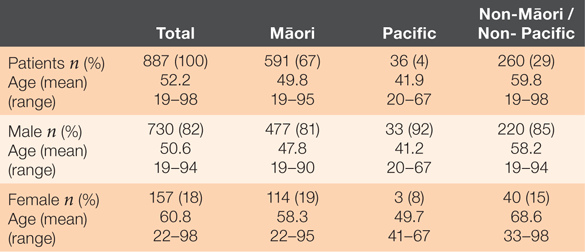
|
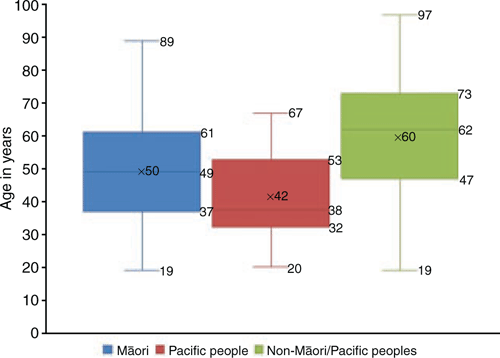
|
Treatment outcomes
The programme was adopted by 36 general practices across Northland. A total of 160 clinicians, including GPs, specialist physician, nurse practitioners and clinicians from Māori health providers, prescribed the programme. Data for 708 patients were analysed, representing 80% of enrolled patients. The remaining 20% of patients are still in the programme or the data had not yet been obtained. Of the three treatment options shown in Box 2, 74% of patients were allocated to option 1, 18% to option 2, 1% to option 3, 3% to the diabetes alternative option and the remaining 4% had no option recorded.
The rate of completion of the programme was 55% (280/505) in the Māori and Pacific group compared to 84% (170/203) in the non-Māori/non-Pacific group. Outcomes by ethnicity for those who completed and those who did not complete the programme are presented in Figures 2 and 3.
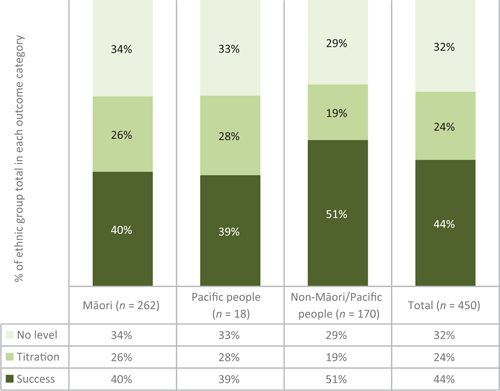
|
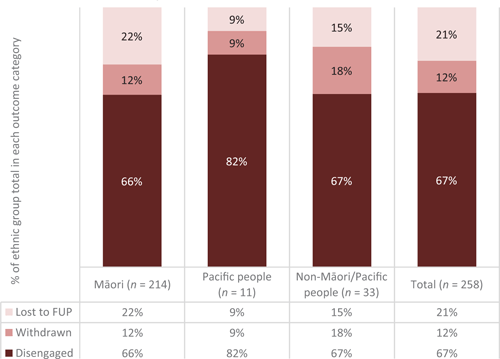
|
Of the total number of patients who completed the programme, 66% (299/450) continued to take allopurinol following completion; 68% (189/280) of Māori and Pacific patients and 65% (110/170) of the non-Māori/non-Pacific group. Eighty-eight patients were enrolled in the programme on more than one occasion; 68 were enrolled on two occasions, 18 on three occasions and two on four occasions. Of these patients, 89% were Māori and 42% have since completed the programme.
Patients who presented in the Emergency Department (ED) with gout and were referred to the programme were followed up by telephone. Seven patients, with 14 presentations to the ED as a result of two patients presenting multiple times, were contacted. On seven occasions, patients were provided a GP voucher and three patients visited a GP and were enrolled in the programme.
Patient outcome questionnaire
Of the 24 patients identified for interview, 21 were contactable and were interviewed; (11 Māori and 10 non-Māori patients). Of these, 16 patients had completed the programme, 13 confirmed that they were still taking the allopurinol and eight recalled having been informed that the medication was required to be taken long term. Most patients (62.5%) had a serum urate test on completion of the programme. The overall rating of the programme was recorded as excellent by 62% of patients and very good by 38%. The questions asked and patient responses are summarised in Table 1.
Discussion
New Zealand research has shown that gout is undertreated and that approximately two-thirds of patients with gout dispensed urate-lowering therapy have not had serum urate levels measured in the following 6 months.3 Consistent with other reports of gout disproportionally affecting people of Māori or Pacific decent,14 the demographic analysis in this research demonstrated a high number of Māori and Pacific people. While the initial goal of enrolling patients in the programme being >70% Māori and Pacific people was achieved, the rate of programme completion was lower in the Māori and Pacific group (55%) compared to the non-Māori/non-Pacific group (84%). Successful completion of the programme was also lower in Māori and Pacific patients at 40% versus 51% in non-Māori/non-Pacific patients.
Factors related to the perception of gout, insufficient understanding of treatment and adherence to long-term treatment, appear to contribute to this disparity.15 This emphasises the need for a flexible programme and the informative role of the Gout Kaiāwhina. Of the patients enrolled more than once, 42% of patients, of whom 89% are Māori, have since completed the programme, suggesting that the re-enrolment of patients is important when addressing health outcome inequities.
There appears to be a need to raise the profile of gout, emphasise the appropriate use of urate-lowering therapy, as well as the importance of a multiple therapy approach to treating acute gout attacks. Urate levels require monitoring on a regular basis, the dose of urate-lowering therapy needs to be adjusted accordingly and prescribed on a long-term basis. The Gout Stop Programme addresses these issues directly by aiding inter-provider collaboration, increasing support for health literacy and ease of prescribing.
In 2016, the Atlas of Health Care variation data for gout in Northland showed a rate of allopurinol use of 43.2% compared to the national rate of 41.6%. In Māori males, the rates were 41.5% in Northland and 39.5% nationally. The rate of non-steroidal anti-inflammatory drug (NSAID) use in patients with gout was lower in Northland at 34.6% compared to the national rate of 37.1%. Among Māori males, the rates were 40.2% and 43.6% respectively (A. Wevers, pers. comm., HQSC, February 2018). It thus appears encouraging that within 1 year of commencing the programme, allopurinol use in Northland was higher and NSAIDs use lower than the national average, particularly for Māori patients.
A US study7 assessed the effect of a pharmacist-staffed gout management clinic and found this more effective than usual care under a primary care physician or rheumatologist in achieving target serum urate levels in gout patients. In NZ, Owning My Gout is a pharmacist-led collaborative gout management project involving community pharmacists and practice nurses where an electronic shared care plan is initiated and community pharmacists titrate allopurinol doses in collaboration with the general practice team. This project demonstrated that community pharmacists can have a role in the titration of allopurinol dosing using standing orders provided by GPs.8
The ultimate success for patients is reaching the serum urate target of ≤0.36 mmol L-1 and continuing to take allopurinol as a long-term medication, to avoid acute gout flares and joint deformities. We found that 68% of Māori and Pacific patients continued taking allopurinol after completion of the programme. Patients require a comprehensive understanding of the treatment and the need for adherence. Longitudinal monitoring of the project will track the programme’s effect on patient outcomes and allow for modifications to the programme in order to achieve higher rates of long-term allopurinol use.
The patient outcome questionnaire showed a disparity between the number of patients confirming they were still taking allopurinol and the number with a good understanding of the need for long-term treatment. This highlights the need for reinforcing patient education and ensuring patient understanding. Reasons for patients not accessing serum urate blood tests were captured as this is an issue documented in previous studies.16 This, along with the fact that 32% of patients who completed the programme had no serum urate measured, supports the recent modification of the programme to include Point-of-Care testing in community pharmacies using BeneCheck meters and urate test strips as an on-site alternative to laboratory tests, and to facilitate appropriate dosing of allopurinol for individual patients at the time of medication dispensing. This approach demonstrates a collaborative and flexible programme that is geared towards meeting the goals and needs of patients and providers.
In 2017, 182 patients presented to the ED at Whangarei Hospital with the primary diagnosis of gout; 69% were Māori, of whom 79% were males (B. Johnson, pers. comm., NDHB, March 2018). A small number of patients were referred to the programme from the ED, suggesting that the process did not meet the needs of all patients or that clinicians were not aware of the programme. Referral of patients between secondary and primary care is important when initiating prevention and treatment of gout in high-needs populations. It is therefore important to understand why people access the ED for non-emergency conditions and to continuously review processes to simplify the path of accessing treatment. Similar to suggestions from other studies,10 there should be a shift in the management of gout from a recurrent acute condition to management as a chronic disease for which there are successful long-term multidisciplinary treatment options. Primary care has a key role in coordinating the prevention and management of such conditions.
The programme was prescription driven and relied on patients being seen by clinicians who had access to the treatment protocol, the presentation and dispensing of prescriptions at community pharmacies, and referral to the Gout Kaiāwhina for support. The data collected were derived from completed patient record forms returned from community pharmacy and participation was open and uncontrolled. The number of patients interviewed was small and only 21 of 24 were contactable, but responses provided lessons for the programme.
The Gout Stop Programme is being expanded to include more structured and culturally appropriate gout education in community pharmacies, enhanced identification of potential gout patients who would benefit from the programme, as well as the identification of patients with gout who present in community pharmacies for over-the-counter NSAIDs with the aim of referring them to a GP.
Conclusion
The Gout Stop Programme highlights the importance of empowering patients to understand the management and prevention of gout, particularly among Māori and Pacific populations. Māori and Pacific males present younger, yet have lower levels of programme completion. To achieve improved medication adherence and gout-related health outcomes, culturally appropriate education and support for patients and whānau are required.
Collaboration between GPs, community pharmacists, community support workers and health organisations is important in initiating prevention in high-needs socioeconomic populations, who have the greatest gout prevalence, and in establishing patients on long-term allopurinol treatment. Each group of health-care professionals has a key role to play in the identification of patients with gout, in successful acute and long-term treatment of gout, and in improvement of equity in health outcomes.
Removing barriers to access of appropriate treatment and serum urate testing is crucial to successful long-term gout management. The importance of treatment adherence and serum urate testing needs to be explained to patients in a comprehensible manner. Clear communication pathways between patients and members of the health-care team is essential in ensuring that all have the information needed to initiate treatment, titrate allopurinol doses and achieve successful long-term outcomes. The Northland Gout Stop programme is evidence based, flexible in approach and makes use of patient outcomes and feedback to inform on-going primary care service delivery, with encouraging results to date.
Competing interests
The authors declare no competing interests.
Acknowledgements
The authors would like to acknowledge the input of the Gout Oversight Group, Iain Buchanan, community pharmacist, and Ian Hartley-Dade, Northland District Health Board, and the rheumatologists and renal team at Whangarei Hospital. They would like to acknowledge the Faculty of Medical and Health Sciences, The University of Auckland, for the funding of the FMHS Summer Research Scholarship. They would like to thank all clinicians in Northland who have prescribed the programme, community pharmacists who have implemented the programme and collected data, and the Gout educators and Gout Kaiāwhina who have engaged with patients and the community, and supported the journey of many patients and their whānau. To the patients who agreed to be interviewed, thank you for sharing your stories.
References
[1] Doherty M, Jansen T, Nuki G, et al. Gout: why is this curable disease so seldom cured? Ann Rheum Dis. 2012; 71 1765–70.| 22863577PubMed |
[2] Roddy E, Zhang W, Doherty M. The changing epidemiology of gout. Nat Clin Pract Rheumatol. 2007; 3 443–9.
| The changing epidemiology of gout.Crossref | GoogleScholarGoogle Scholar | 17664951PubMed |
[3] Health Quality and Safety Commission. Atlas of Healthcare Variation. Gout, 2018. [cited 2018 October 01]. Available from: https://www.hqsc.govt.nz/our-programmes/health-quality-evaluation/projects/atlas-of-healthcare-variation/gout/
[4] Krishnan E, Lessov-Schlaggar CN, Krasnow RE, et al. Nature versus nurture in gout: twin study. Am J Med. 2012; 125 499–504.
| Nature versus nurture in gout: twin study.Crossref | GoogleScholarGoogle Scholar | 22365026PubMed |
[5] Merriman TRDalbeth NJohnson RJ. Sugar-sweetened beverages, urate, gout and genetic interaction. Pacific health dialog: A publication of the Pacific Basin Officers Training Program and the Fiji School of Medicine. Pacific Health Dialog 2014 ; 20 (1 ): 31–8.
[6] Arroll B. Treating acute gout and starting prevention in 7 minutes. Goodfellow Learning Site; 2015. [cited 2015 May 05]. Available from: https://www.goodfellowunit.org
[7] Goldfien R, Pressman A, Jacobson A, et al. A pharmacist-staffed, virtual gout management clinic for achieving target serum uric acid levels: a randomized clinical trial. Perm J. 2016; 20 15–234.
| 27352414PubMed |
[8] Phone D.. Owning My Gout – A Pharmacist-led collaborative gout management model at Counties Manukau DHB. Int J Integrat Care 2017; 18 A38.1–8.
[9] Statistics New Zealand. 2013 Census QuickStats about a place: Northland Region. [cited 2019 February 03]. Available from: https://www.archive.stats.govt.nz/Censerum urates/2013-censerum urates/profile-and-serum uratemmary-reports/quickstats-about-a-place.aspx
[10] Spencer K, Carr A, Doherty M. Patient and provider barriers to effective management of gout in general practice: a quantitative study. Ann Rheum Dis. 2012; 71 1490–95.
| Patient and provider barriers to effective management of gout in general practice: a quantitative study.Crossref | GoogleScholarGoogle Scholar | 22440822PubMed |
[11] Horsburgh S, Norris P, Becket G, et al. Allopurinol use in a New Zealand population: prevalence and adherence. Rheumatol Int. 2014; 34 963–70.
| Allopurinol use in a New Zealand population: prevalence and adherence.Crossref | GoogleScholarGoogle Scholar | 24390636PubMed |
[12] To Stop Gout booklet. Auckland: Workbase Education Trust; 2014.
[13] Gout Stop 2016 - Interviews with Georgia Grant-Mackie and Dr Aniva Lawrence. Whangarei: Northland District Health Board; 2016. [cited 2018 January 12]. Available from: https://www.youtube.com/watch?v=svyrFaUHPx8
[14] Dalbeth N, House ME, Horne A, et al. The experience and impact of gout in Māori and Pacific people: a prospective observational study. Clin Rheumatol. 2013; 32 247–51.
| The experience and impact of gout in Māori and Pacific people: a prospective observational study.Crossref | GoogleScholarGoogle Scholar | 23114632PubMed |
[15] Te Karu L, Bryant L, Elley CR. Maori experiences and perceptions of gout and its treatment: a kaupapa Māori qualitative study. J Prim Health Care. 2013; 5 214–22.
| Maori experiences and perceptions of gout and its treatment: a kaupapa Māori qualitative study.Crossref | GoogleScholarGoogle Scholar | 23998172PubMed |
[16] Sarawate CA, Brewer KK, Yang W, et al. Gout medication treatment patterns and adherence to standard of care from a managed care perspective. Mayo Clin Proc. 2006; 81 925–34.
| Gout medication treatment patterns and adherence to standard of care from a managed care perspective.Crossref | GoogleScholarGoogle Scholar | 16835972PubMed |


